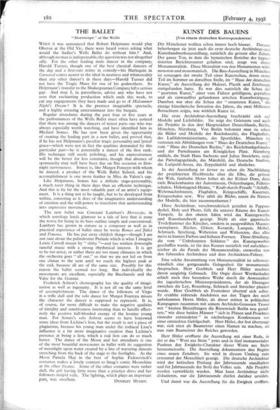THE BALLET
"Horoscope" at the Wells Regular attendants during the past four or five years at the performances of the Wells Ballet must often have noticed that there was among the dancers of minor parts one who was always especially worth watching, and have identified him as Michael Somes. He has now been given the opportunity of creating the leading part in a new ballet, and proved that, if he has not Helpmann's peculiar tragic personality and lyrical grace—which were not in fact the qualities demanded by this particular part—he is potentially a dancer of the first rank. His technique still needs polishing, and his expressiveness will be the better for less constraint, though that absence of spontaneity may well have been due on this occasion to first- night nervousness. Somes is, like Margot Fonteyn with whom he danced, a product of the Wells Ballet School, and his accomplishment is one more feather in Miss de Valois's cap.
Like Helpmann, Somes has a definite stage-personality, a much rarer thing in these days than an efficient technique. And this is by far the most valuable part of an artist's equip- ment. It is a thing not to be taught, but to be developed from within, consisting as it does of the imaginative understanding of emotion and the will-power to transform that understanding into expressive movement.
The new ballet was Constant Lambert's Horoscope, in which astrology lends glamour to a tale of love that is none the worse for being in its bare outline simple and conventional. Lambert has grown in stature as a composer as well as in practical experience of ballet since he wrote Romeo and Juliet and Pomona. He has put away childish things—though I am not sure about the palindromic Prelude which is what I imagine Lewis Carroll meant by " slithy "—and has written downright tuneful music with a strong rhythmical interest. It is apt to be too noisy, or rather there are too many climaxes in which the orchestra goes "all out," so that we are not led on from one climax to the next until we reach the highest peak at the end, because all are of the same size. Possibly for this reason the ballet seemed too long. But individually the movements are excellent, especially the Bacchanale and the Valse for the Gemini.
Frederick Ashton's choreography has the quality of imagi- nation as well as ingenuity. It is not all on the same level of accomplishment. The dance of the followers of Virgo is a trifle dull and the solo dance for Margot Fonteyn misses the character the dancer is supposed to represent. It is, of course, far more difficult to make the negative qualities of timidity and sensitiveness interesting than to handle effect- ively the positive full-blooded energy of the leonine young man. For Somes's solo Ashton seems to have borrowed some ideas from Lichine's lion, but the result is not a piece of plagiarism, because his young man under the zodiacal Lion's influence is a far more imaginative creation than Lichine's pretence at being a lion, which a real lion can do so much better. The dance of the Moon and her attendants is one of the most beautiful movements in ballet with its suggestion of moonlight upon water created by a line of wavering dancers stretching from the back of the stage to the footlights. As the Moon Pamela May in the best of Sophie Fedorovitch's costumes makes a lovely contrast to Snug's comic Moonshine at the other theatre. Some of the other costumes were rather dull, the girl having little more than a practice dress and her followers insipid veils. The lighting, which plays an important














































 Previous page
Previous page